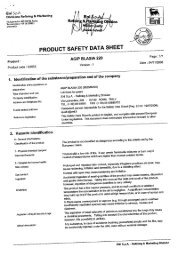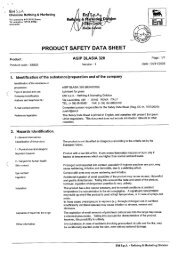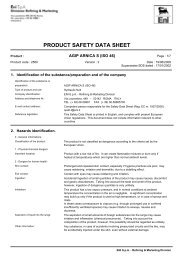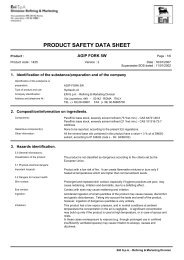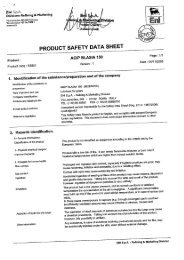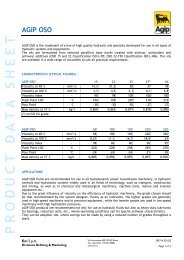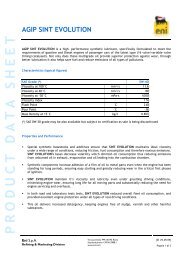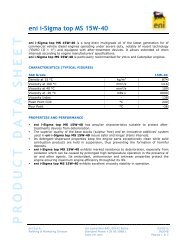eni blasia ml (iso vg 320) ghs sds 32-2950 - TransDiesel
eni blasia ml (iso vg 320) ghs sds 32-2950 - TransDiesel
eni blasia ml (iso vg 320) ghs sds 32-2950 - TransDiesel
You also want an ePaper? Increase the reach of your titles
YUMPU automatically turns print PDFs into web optimized ePapers that Google loves.
ENI BLASIA ML (ISO VG <strong><strong>32</strong>0</strong>)<br />
Chemwatch GHS Safety Data Sheet<br />
Issue Date: 31-Jul-2012 CHEMWATCH <strong>32</strong>-<strong>2950</strong><br />
C868SP<br />
Version No:3.1.1.1<br />
CD 2012/3 Page 3 of 6<br />
Section 7 - HANDLING AND STORAGE<br />
PROCEDURE FOR HANDLING<br />
• Avoid all personal contact, including inhalation.<br />
• Wear protective clothing when risk of exposure occurs.<br />
• Use in a well-ventilated area.<br />
• Prevent concentration in hollows and sumps.<br />
SUITABLE CONTAINER<br />
• Metal can or drum<br />
• Packaging as recommended by manufacturer.<br />
• Check all containers are clearly labelled and free from leaks.<br />
STORAGE INCOMPATIBILITY<br />
■ CARE: Water in contact with heated material may cause foaming or a steam explosion with possible severe burns from wide<br />
scattering of hot material. Resultant overflow of containers may result in fire.<br />
• Avoid reaction with oxidising agents.<br />
STORAGE REQUIREMENTS<br />
• Store in original containers.<br />
• Keep containers securely sealed.<br />
• No smoking, naked lights or ignition sources.<br />
• Store in a cool, dry, well-ventilated area.<br />
Section 8 - EXPOSURE CONTROLS / PERSONAL PROTECTION<br />
EXPOSURE CONTROLS<br />
MATERIAL DATA<br />
ENI BLASIA ML (ISO VG <strong><strong>32</strong>0</strong>):<br />
■ Toxicity and Irritation data for petroleum-based mineral oils are related to chemical components and vary as does the<br />
composition and source of the original crude.<br />
A small but definite risk of occupational skin cancer occurs in workers exposed to persistent skin contamination by oils over<br />
a period of years.<br />
Petroleum oils which are solvent refined/extracted or severely hydrotreated, contain very low concentrations of both.<br />
MINERAL OIL:<br />
■ for mineral oils (excluding metal working fluids), pure, highly and severely refined:<br />
Human exposure to oil mist alone has not been demonstrated to cause health effects except at levels above 5 mg/m3 (this<br />
applies to particulates sampled by a method that does not collect vapour). It is not advisable to apply this standard to oils<br />
containing unknown concentrations and types of additive.<br />
PERSONAL PROTECTION<br />
RESPIRATOR<br />
•Type A Filter of sufficient capacity. (AS/NZS 1716 & 1715, EN 143:2000 & 149:2001, ANSI Z88 or national equivalent)<br />
EYE<br />
• Safety glasses with side shields<br />
• Chemical goggles.<br />
• Contact lenses may pose a special hazard; soft contact lenses may absorb and concentrate irritants. A written policy document,<br />
describing the wearing of lens or restrictions on use, should be created for each workplace or task. This should include a<br />
review of lens absorption and adsorption for the class of chemicals in use and an account of injury experience. Medical and<br />
first-aid personnel should be trained in their removal and suitable equipment should be readily available. In the event of<br />
chemical exposure, begin eye irrigation immediately and remove contact lens as soon as practicable. Lens should be removed at<br />
the first signs of eye redness or irritation - lens should be removed in a clean environment only after workers have washed<br />
hands thoroughly. [CDC NIOSH Current Intelligence Bulletin 59], [AS/NZS 1336 or national equivalent].<br />
HANDS/FEET<br />
■ The selection of the suitable gloves does not only depend on the material, but also on further marks of quality which vary from<br />
manufacturer to manufacturer. Where the chemical is a preparation of several substances, the resistance of the glove material can<br />
not be calculated in advance and has therefore to be checked prior to the application.<br />
The exact break through time for substances has to be obtained from the manufacturer of the protective gloves and<br />
has to be observed when making a final choice.<br />
continued...







